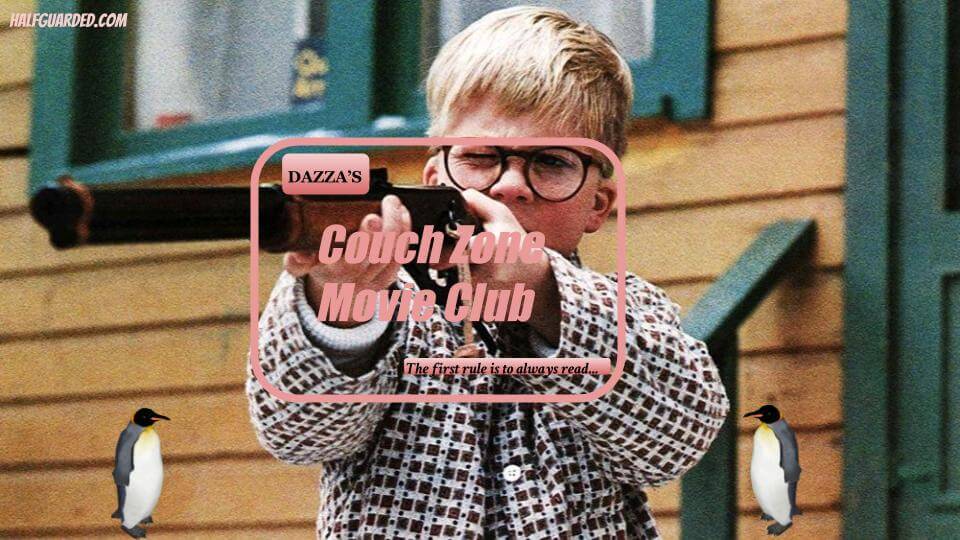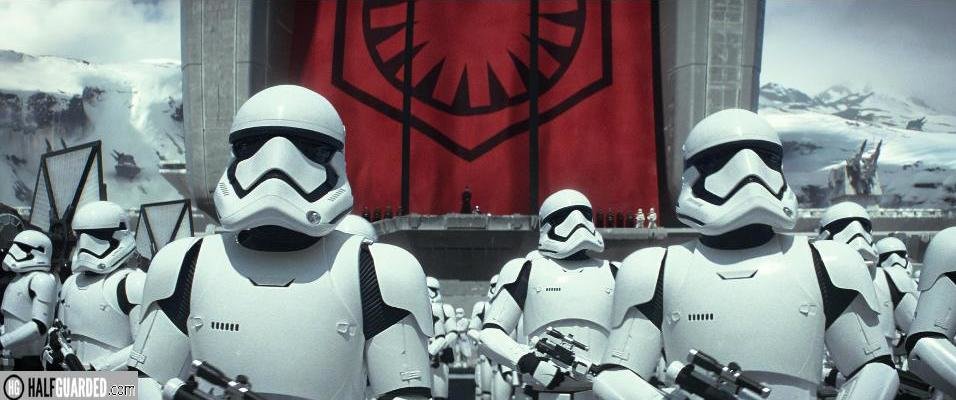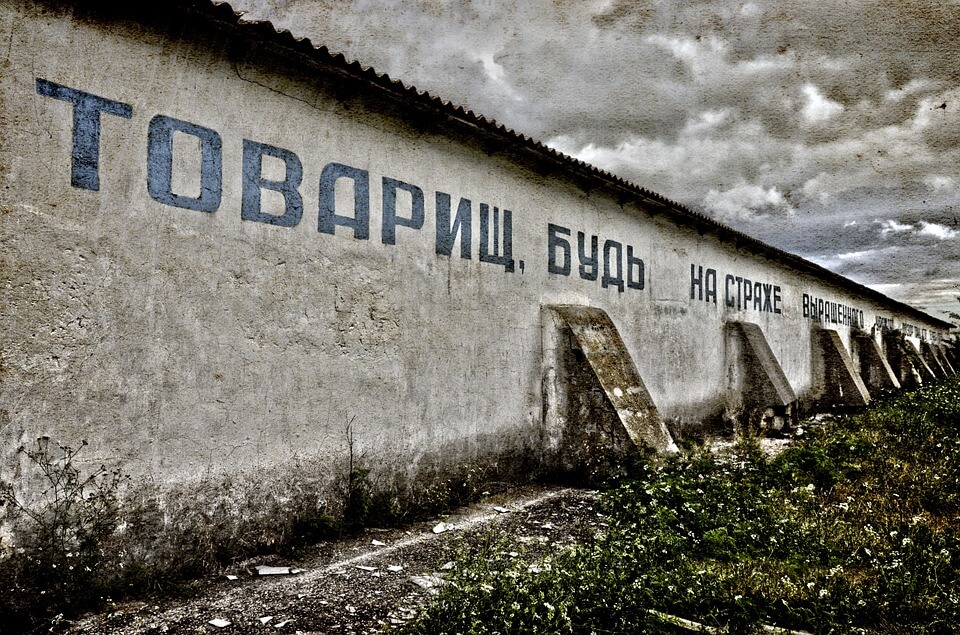1983 and music was changed forever. The Compact Disc appeared in stores and news reporters were eager to show that they could continue to play even when smeared in marmalade. This of course had been a famous drawback with vinyl records.
Meanwhile in movies…….
A Christmas Story

What is the greatest Christmas movie of all time? Let me rephrase that. What is the film that best encompass the feeling and experience of Christmas? Because unless you’ve had to fight through a building full of terrorists on Christmas Eve, I’m better that is going to change your answer.
Personally, the chaos and absurdity of the festive season is best expressed in “A Christmas Story,” a film that sees Christmas through the eyes of a young boy in 1930’s Indiana. It’s a hilarious film, based on stories and anecdotes from “In God we Trust: All others pay cash,” the memoirs of radio host Jean Shepherd. The film is narrated by the real life Shepherd as we watch the adventures of his childhood self played brilliantly by twelve year old Peter Billingsley (although the character is more around the age of nine). This narrative style resembles the one employed in the TV show The Wonder Years.
The film is a scattershot of incidents and misadventures that happen to the young lad during the build up to the big Christmas day. There are incidents such as run ins with the school bully and problems with the neighbours and their pack of pet dogs, and a long running feud between his parents over a novelty lampshade. The father wins the lampshade in a competition which is shaped like a women’s leg in a fish net stocking, which he adores but the mother disproves and finds it abhorrent.
Other random tales involve a dare to lick a frozen lamp post which results in a poor lad getting his tongue stuck to the post (it’s perversely hilarious as he stands there trapped while his classmates panic and do a runner) and a crisis for the parents when young Ralphie let’s slip the “F-word” in front of his dad. When interrogated as to where he heard the word he drops of the name of one of his friends instead of admit he’s heard his father say it hundreds of times when trying to fix the boiler.
These disparate stories are linked together by an ongoing arc involving Ralphie and his dream Christmas present. Ralphie is obsessed by a “Red Ryder BB gun” for which he schemes to change the mind of his parents who claim he’ll “shoot his eye out with it.” His quest leads him to visit a grumpy department store Santa and make the BB gun the subject for a class essay for his teacher, but the response he continues to get from adults is always “you’ll shoot your eye out with it.”
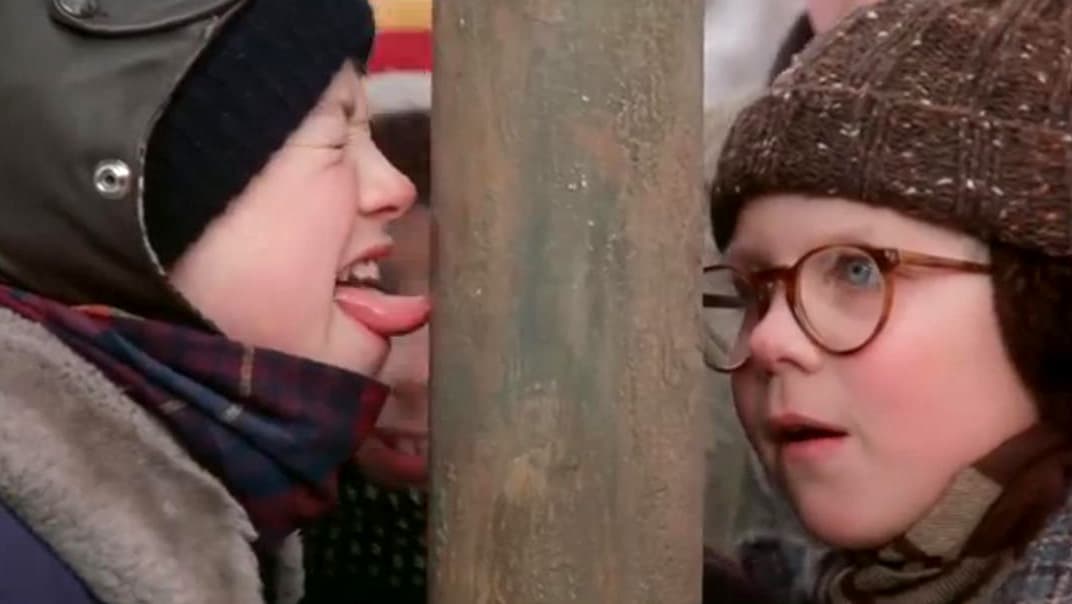
The humour which is riotously funny is heightened by the dry delivery of Shepherd’s narration, giving an adult wit to the inner voice of Ralphie. It perfectly conveys the baffling nature of adults as seen through the eyes of a child, especially at the most bizarre and stressful of holidays. All the traditions are covered, the family visits, the buying of the Christmas tree and decorating of the house and the unwrapping of presents including the obligatory unwanted one from the deranged relative (in this case a pink bunny suit Ralphie is forced to model).
Although the film on it’s release was only a mild success, it’s charming nature that has appeal to both adults and children meant it slowly worked itself into the Christmas television tradition. Rights to the film were bought by Time Warner and it became a staple of the December schedule where it enjoys high ratings to this day. It’s even customary now for the turner networks to host a 24 hour marathon of the film, playing non stop throughout the day.

The Outsiders
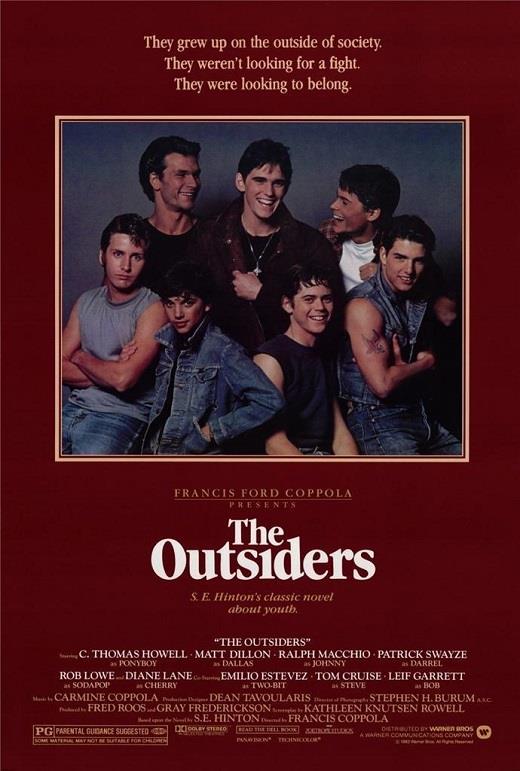
I was about 14, it was the end of the school year and as is tradition some of the teachers started to not give a fuck as the bright freedom of Summer edged ever tantalisingly closer. In order to keep us little shits quiet teachers at our school would stick several classes into one room and wheel in the school TV and video, sticking on a film on that they could loosely claim had some educational merit (or failing that whatever one of the teachers could get his hands on, one bizarre time we were treated to a showing of a obvious pirate copy of Rambo III which wasn’t even out for another month in the UK . One of the better choices was in English class when we got to watch The Outsiders, directed by Francis Ford Coppola and based on the novel by S E Hinton.
I’d not heard of this film but was enjoying it, or trying to as unfortunately the rest of the class were largely yobs and commandeered the remote control so that they could “put fookin feighting bit on!” (translation from Barnsley speak“fast forward to the fight scenes”). As such I got a fractured viewing of The Outsiders, but saw enough to want to see the whole thing and didn’t have to wait long as BBC 2 just happened to show the film not long after.
It was shown on the BBC dream platform for cult and independent movies known as Moviedrome, a series that was presented by ALex Cox and I absolutely adored as a growing film fan. The Outsiders was shown as part as an inspired doublebill with the similar themed Rumble Fish also directed by Coppola.
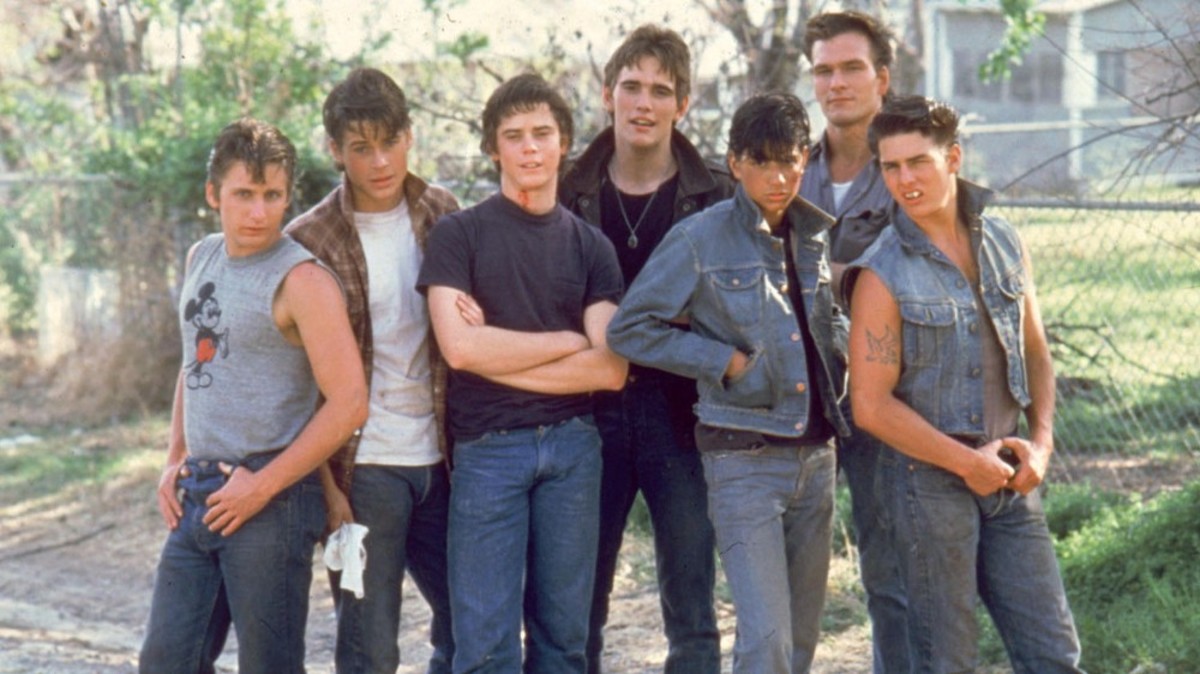
The Outsiders is a grittier version of the 80’s “coming of age” movies that would soon become the defining genre of the 80’s. It’s set in Oklahoma and surrounds a working class gang known as the “greasers” who are in a rivalry with the kids from the wealthier side of town called the “socs.” One night two of the younger and more innocent greasers (Ponyboy and Johnny) get into an altercation with a gang of socs, that ends with Johnny stabbing one of their attackers to death.
The duo are advised by their older friend Dallas to flee town and hide out in a remote church. While in hiding the boys end up as heroes when they save a group of school children from a burning fire, which leaves Johnny badly injured. Ponyboy returns home to find that an all out “rumble” has been arranged between the Greasers and the Socs.
Although mainly unknowns at the time, the cast of Outsiders would prove to be an impressive array of future stars. Ponyboy and Johnny are played by Thomas Howell and Ralph Macchio. Ponyboy’s brothers are played by Patrick Swayse and Rob Lowe. Their buddy Two-Bit is played by Emilo Estevaz, while Tom Cruise appears as Randle ( a rough looking character who is unrecognisable from the heart throb who would come to prominence in Risky Business that same year). Diane Lane is the Soca who befriends Ponyboy and almost provides a love interest. But stealing the film in terms of presence is Matt Dillon as the streetwise and ultimately doomed loose cannon “Dallas.”
The makeup of this cast has seen the Outsiders be regarded as one of the first films of the “Bratpack” genre. This term refers to a loose collection of actors and actresses in their early 20’s who appeared in 80’s coming of age movies. This was a modern take on the Sinatra led Ratpack of the 50’s and 60’s. However unlike that group there was no official lineup of members and the term was not embraced by the performers, instead being the brainchild of a journalist for New York Magazine.
/cdn.vox-cdn.com/uploads/chorus_image/image/51613991/Greasers.0.jpg)
Incidentally if you’re not aware of the cast before hand, you soon will be. Because The Outsiders has one of the longest, tedious opening credits ever made, as the title slowly pans across the screen against a bright yellow sunset. This is followed by a roll of the players in this film, split between “Greasers” and “Socs” with all the splendor as if it’s Gone With The Wind we’re about to watch and not a tough film of streetwise youths. All the while there plays a mawkish, sickly sweet theme song by Stevie Wonder that had the classroom full of teenagers I was stuck with rolling their eyes and muttering “Oh God,” in that frustrated, tired privileged teenage way.
While the theme music is a weird choice for a film about kids from the wrong side of the tracks, The Outsiders plays heavy with the sentimental card. It’s tone does not stray far from it’s young adult novel roots, to give voice to the underclass youths but provide a story of hope, giving rise to the iconic dying plea of Johnny “Stay Gold, Poneyboy.”
It’s a film that your reaction to it will probably depend on the age of when you first saw it. I saw it at the perfect age, lapping up the mostly sanitised gang rivalry but also becoming invested in the redemption story of saving the kids in the church and being touched by the comradely and brotherhood of the Greasers. It’s very much a movie of being a teen, where adults rarely appear with the only parents we ever see are those who are abusive to their kids.
There are many things to take away from The Outsiders, but what resonated with me was despite the class differences between the Soc’s and the Greasers how very similar they were as teens. Both sides were violent, revelling in the rivalry and the excitement of the fights it led to. Both sides do the things teens do, going to movies, hanging around drinking. There’s a moment I always find sad at the start where some of the younger Greasers meet several Soc girls at the movies. They get on and Two-Bit seems to have really charmed one of the girls. He gets her number, but after throws it away sadly accepting that it could never work out with a nice girl like her.
Another example of this is when the two sides meet up for the epic rumble and Patrick Swayse’s Darrell (who despite been Ponyboy’s older brother and parent figure still takes part in the rumble) greets and square’s up with the leader of the Soc’s. It turns out the two where highschool friends and there’s a weird sense of sadness as the two agree to take on each other in the rumble, their standing in their respective gangs taking precedence over their feelings for each other.
But I have to admit, for all the themes and conscience in the film with Ponyboy’s story of staying Gold, as a teen it was all about the rumble, the fight to settle the score between the Greasers and the Soc’s. The build up is great, with the sense of comradely of the Greasers as they holler and cheer as they make their way to the apocalyptic battle. There’s also a tense wait as the gang (their numbers swelled by greaser allies who seem a lot rougher and nastier than the group with been following, but of course we don’t know their back stories) watch as the Soc’s appear in the distance their car headlights cutting through the woods.
The fight itself is epic, all brawling and wild swinging fist fighting (though not realistic the style resembles old school western bar fights), with a melodramatic touch with storm that comes out of no where and drenches the combatants in rain and mud. It’s real macho, man on man stuff, but fought honourably as they agree before on no weapons and it comes across as fun, especially watching Tom Cruise and Matt Dillon going absolutely apeshit in there. And yeah in the very 80’s move does glorify the violence as the brawl is exciting and when the Greasers win it is accompanied by stirring, triumphant music that borders on the sentimentally romantic. Only the reaction of the dying Johnny in the hospital treating the news of the victory with disdain tempers the glory exhibited around the fight.
So yeah, when I think about it I was into the fight as much as all the other arseholes in the classroom.

The Twilight Zone

When I was a kid I was actually quite a sensitive soul and though I would make up for it when I got my mid teens I hated horror movies. I would get freaked out by trailers for horror movies (believe it or not there was a time when trailers for X rated films would be shown at kids movies. For example I remember Friday 13th Part II being shown before Condorman), and in my trips to the video store I couldn’t even glimpse at the giant wall of lurid horror video covers.
So it was a surprise to my parents that I sat down with them to watch the television premiere of The Twilight Zone Movie on ITV. Five minutes in and they were probably taking bets on how long I’d last after the intro to the film ends with Dan Ackroyd in a car asking his driving companion if he wants “to see something really scary” before turning into a hideous, shieking monster and tearing the head off him.

Fortunately I fought back against the urge to run into my room and put on my betamax tape of battle beyond the stars and stuck it out. Because Twilight Zone in gore terms proved to be quite light and helped to break me gently into horror movies, a bit like smoking marijuana as a build up to crack cocaine.
The twilight zone is of course based on the 60’s TV show and is an anthology movie built up of four short stories, three of them based on stories from the original series.
In “It’s a Good Life,” directed by Joe Dante is a creepy tale of a young boy with the power to manipulate reality and uses it imprison people into a surrogate family and create a fantasy existence full of joy. It’s a whacky story full of surreal imagery, such as the boy punishing one of his “family” members by transporting her into the TV to be chased and killed by cartoon animals.
“Kick the can,” directed by Stephen Spielberg is the odd story of the bunch. A sweet tale of the residents of an old folks home being allowed one night to play as kids again by a mysterious stranger. It’s a nice story but doesn’t really fit in with the scary expectations of the Twilight Zone.
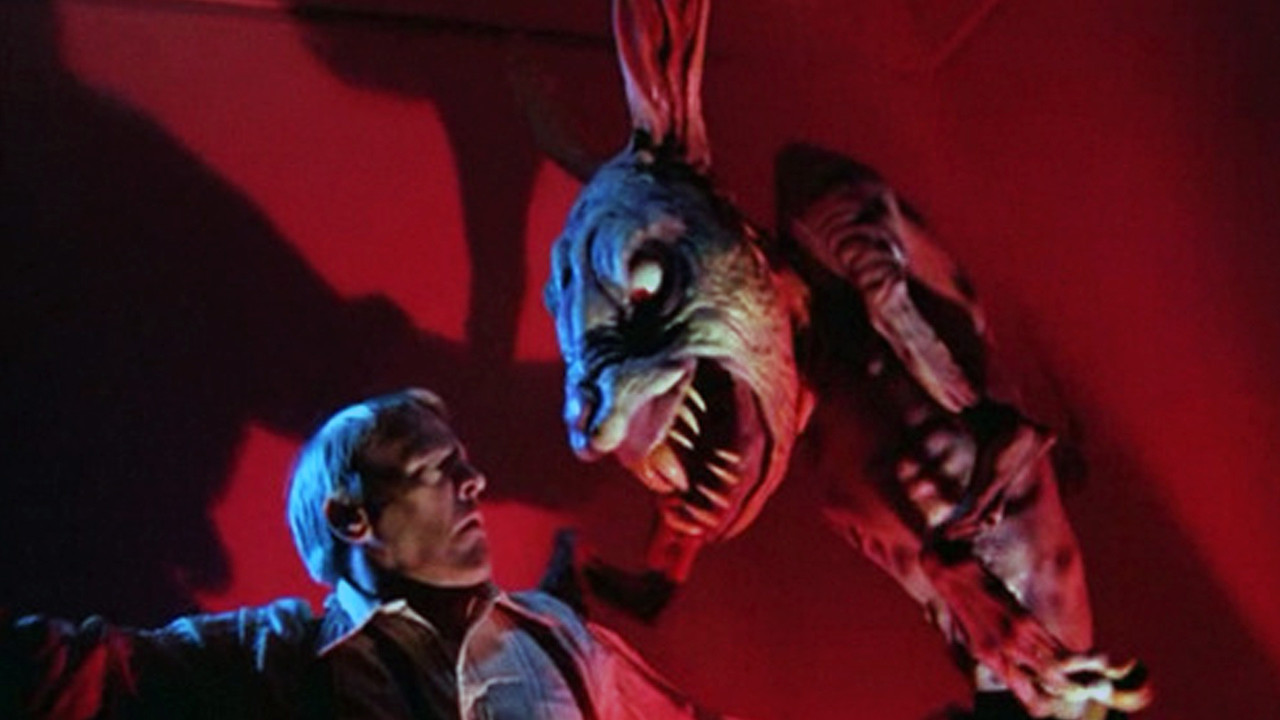
The scariest of the stories was a remake on the most beloved of the Twilight Zone episodes the William Shatner starring “Nightmare at 20,000 Feet.” Directed by George Miller, it’s the tale of a man with a fear of flying already in fear as the plane passes through a heavy storm and who repeatedly sees a creature on the wing of the plane (although I have zero fear of flying I always think of this film when I’m seated next to wing). Played with convincing panic and paranoia by John Lithgow, it’s a tense story as he’s repeatedly harassed by the creature and his warnings to the airline crew are frustratingly but understandable dismissed. The creature itself is genuinely terrifying and grotesque, a slimey, creepy alien like unsettling mannerisms and a marvel of animatronics. One of the best parts of the movie sees Lithgrow, trying to sleep but can’t help obsessing about the closed passenger window. Eventually he can’t resist and has to lift the shade to find the face of the monster snarling at him as if it’s personally toying with him.
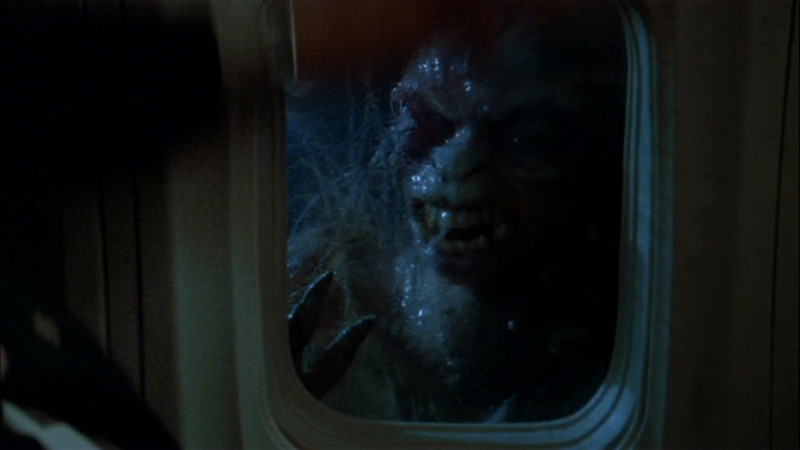
My favourite story however was the opener “Time Out,” directed by John Landis and starring Vic Morrow. Morrow plays a bitter racist, who after a rant in a bar one night walks outside and finds himself in Nazi Germany where everyone sees him as a Jew. After running from Nazi troops he finds himself transported to 1950’s American South at a Klan meeting where he is seen as black and narrowly escapes being lynched. After escaping he finds himself in Vietnam where he encounters American troops who see him as Vietcong and attack him. Finally he finds himself back in Nazi Germany where he is captured and sent on a train with other Jews to a concentration camp.
I loved the story with it’s ironic punishment and Morrow’s character reaping the hatred that he has let overcome him. It’s incredibly dark and with such a bleak, downbeat but fitting ending. Years later I learned of the very real horror that surrounded the making of this segment.
Originally the story was to have a more redemptive conclusion. The story was to end with Morrow back in Vietnam where he stumbles across two children in a Vietnamese village under attack from an American helicopter. The final scene was to see Morrow carry the two childen through a stormy river, while a helecopter in the background flew over the exploding village. Tragedy struck as one of the explosions went off too near the helicopter and sent it crashing into the ground where the rotas struck and killed Morrow and the two children Myca Dinh Le and Renee Shin-Yi Chen, all of this caught on camera.
The story was changed to tie in with the footage already shot. I’ve never watched the film again as it’s unsettling watching Morrow knowing that this is essentially the film that would kill him. Also horrific was the revelations in the subsequent trial that several child labour laws were circumvented to allow the scenes to take place, such rules against children working at night or being near explosions. The children were apparently paid under the table to keep their participation secret and were hidden from fire safety inspectors visiting the filming of the scene. There were some concerns about the dangerous nature of the stunt from some crew members before hand and a clip of Morrow with the two children in the river that I saw on a news report on the trial (the only clip I have ever watched, I’ve never sought out the graphic scenes which apparently exists) looked disturbing and out of control even before the accident of the helicopter.
Despite these seemingly damning elements no one went to jail over this, although safety laws on movie sets were massively overhauled after this.

WTF?????????
Never Say Never Again

Something just didn’t seem right in 1983 when I went to see Never Say Never Again.
For a start, there had already been a James Bond film that year with Roger Moore in Octopussy (only four months previous in fact.) And there was just a weird vibe surrounding this one, even if it did see a return to the role by the original movie bond, a beginning to wrinkle Sean Connery. Especially strange was that this film was going to be essentially a remake of Connery’s earlier Bond film Thunderball (for a long time one of my favourite Bond movies despite it been derided by many). Add to this a new actor playing Q and Miss Moneypenny suddenly being played by a young blonde and well this all felt a little odd.
Anyway I sat in the cinema, awaiting the iconic James Bond gunshot opening with that wonderful Bond scene, expecting it to no doubt morph into an opening credits with silhouetted naked women and some catching James Bond song. But instead of Bond shooting at the screen I got wall of 007 logos filling the screen and an opening credits over Connery storming a lair of bad guys with some woman singing out of her arse what apparently was the theme to Never Say Never Again (Bonnie Tyler was originally the singer but backed out because she thought the song was shite).
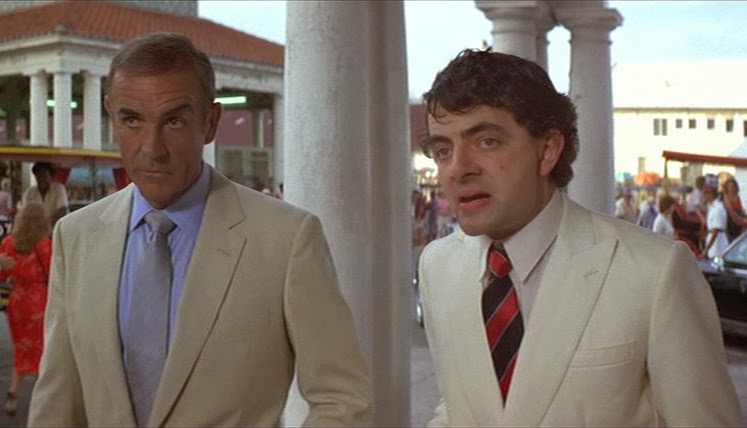
If today’s internet covering every moment of a film’s development had been around back then I would have realised that the weirdness surrounding NSNA, was because this was kind of an official Bond movie, outside of the cannon of the Moore films and even Connery’s early films in the role.
You see back before James Bond had appeared in Dr NO, Ian Fleming co wrote a potential Bond script with a guy called Kevin McClory. The film never happened, so Fleming went and turned the script into the novel Thunderball. Mcclory went “Hold on you twat, I wrote that story” and claimed he was just entitled to the story and the creation of the Bond villains Blofeld and Spectre. A judge agreed. As a result when Eon Prodcutions started making Bond films they had to make a deal with Mcclory for the use of the Thunderball story, taking him on as a producer and allowing him the right to make his own Thunderball film after a ten year period.
Naturally after ten years when Mcclory started developing his version of Thunderball there were more lawsuits back and forth and the rights to the use of the Spectre characters were called into question (which is why the organisation doesn’t feature in the Roger Moore and subsequent Bond eras.
In any case Mcclory managed to pull off a coup by getting Connery involved in the film as a producer and finally convincing him to appear as Bond even after the actor had sworn he was done after Diamonds are Forever. Story is that Connery was motivated to appear as a way to stick it to his former bosses at Eon, as well as packet a ton of money.
Anyway this convoluted story is infinitely more entertaining than what appeared on the screen, which comes across as a pointless remake and I found really boring and cheap, ladled with lame humour such as Rowan Atkinson as a bumbling assistant to Bond. In truth though the Bond franchise was going through a rough patch anyway, the films were starting to feel stagnant. NSNA at least scored a few points creatively by acknowledging an ageing past his best Bond and depicting the secret service department as run down and underfunded. Even so, seeing old Connery wooing a young Kim Bassinger is a little creepy.
As for Spectre, after many years of fans begging for the return of the shadowry organisation the rights for them would finally be sorted out. This allowed the making of the Daniel Craig movie Spectre. This sadly proved to be shite as well.

That’s all for this time, but wait are those ads for a couch zone movie t-shirt????????
see ya
Dazza

